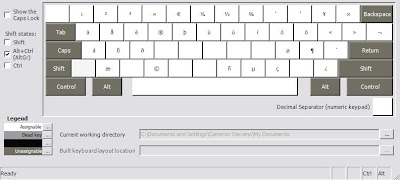My sister-in-law finally surrendered to the necessity for a new laptop and my brother enlisted me to do what I seem to do best, help spend money. My sister-in-law (and brother for that matter) speak french and in both personal and business applications use french words that require accented characters. Fortunately most laptops available these days have a multilingual keyboard that can accommodate these characters, though the truth of the matter is you don't need a special keyboard to type résumé correctly. There is a wonderful keyboard definition which is called US-International (formerly US-Multilingual) that does a fine job. For those who learned on a truly language specific keyboard, there's a method and accompanying madness that allows you to use the special keys offered by the 'Alt Gr' or 'Alt Car' key (which is the right Alt key to most of us).
To help me try to explain this, because my sister-in-law is not here to tell me what she was really expecting for behaviour, I am employing the Microsoft Keyboard Layout Creator (MSKLC) to view and compare the different layouts. This tool is actually meant to allow anyone to create their own custom layout (ideally based on an existing keyboard but I might see how far I can take this later as to whether this would be valuable in doing custom POS or proprietary systems).
I am accustomed to the US-International configuration for utilizing accents and such, it's a simple and generic manner of generating the required effects because it doesn't change the key assignments from the standard keyboard, but enhances the keyboard through prefixing keystrokes. For example the é character is generated with a single quote (')+e in that order. a 'ç' is generated in the same manner ('+c). The umlatted characters are prefixed by the double-quote (") for ë, and the other prefix keys are the tilde (~), carat (^), and left-single quote (`) as used for ñ, â, and à. There are many more characters that are possible using that right Alt key, such as: ¡, €, ¥, ä, ®, ©, ñ, and ¿ (this is not a complete list, check here for the Microsoft Knowledge base article).

So, using this layout is great for the bulk of us, though we may have somewhat of a learning curve trying to understand and remember all of the unmarked and special characters. Let's have a look at how the language bar actually works because this will be the most efficient method by which to change the layout on-the-fly.
The Language bar can either be docked into your Start Bar or floated around your screen in a location of your choosing, it can even be made semi-transparent. It looks like this:
 or
or 
Note that the language bar only becomes available if there's more than one language and/or keyboard layout defined. I have EN (english) and FR (french) with FR offering two keyboard layouts (Canadian French and US-International). If you want to add a language or keyboard layout you will need to use the Control Panel, select "Date, Time, Language, and Regional Options", then click "Regional and Language Options" in the lower-right of the window. This will bring up the Regional and Language Options, select the Language tab and click on 'Details'.



No comments:
Post a Comment